Choosing the right industrial lighting can be a game-changer for your workspace. At PacLights, we understand the importance of selecting the perfect 400W metal halide high bay lights for your needs.
These powerful fixtures offer bright illumination for large, high-ceiling areas. In this guide, we’ll explore the key factors to consider when making your selection, ensuring you get the best lighting solution for your facility.
What Are Metal Halide High Bay Lights?
Metal halide high bay lights provide powerful illumination for large, high-ceiling spaces. These fixtures use a gas discharge lamp that produces light by passing an electric arc through a mixture of vaporized mercury and metal halides. The result is a bright, white light that closely mimics natural daylight.
Key Features of 400W Metal Halide Fixtures
400W metal halide high bay lights offer impressive illumination. They typically produce about 36,000 to 44,000 lumens, depending on the bulb’s quality and age, making them suitable for spaces with ceilings ranging from 15 to 40 feet high. However, this output can decrease by up to 40% over the fixture’s lifespan (usually around 15,000 to 20,000 hours).
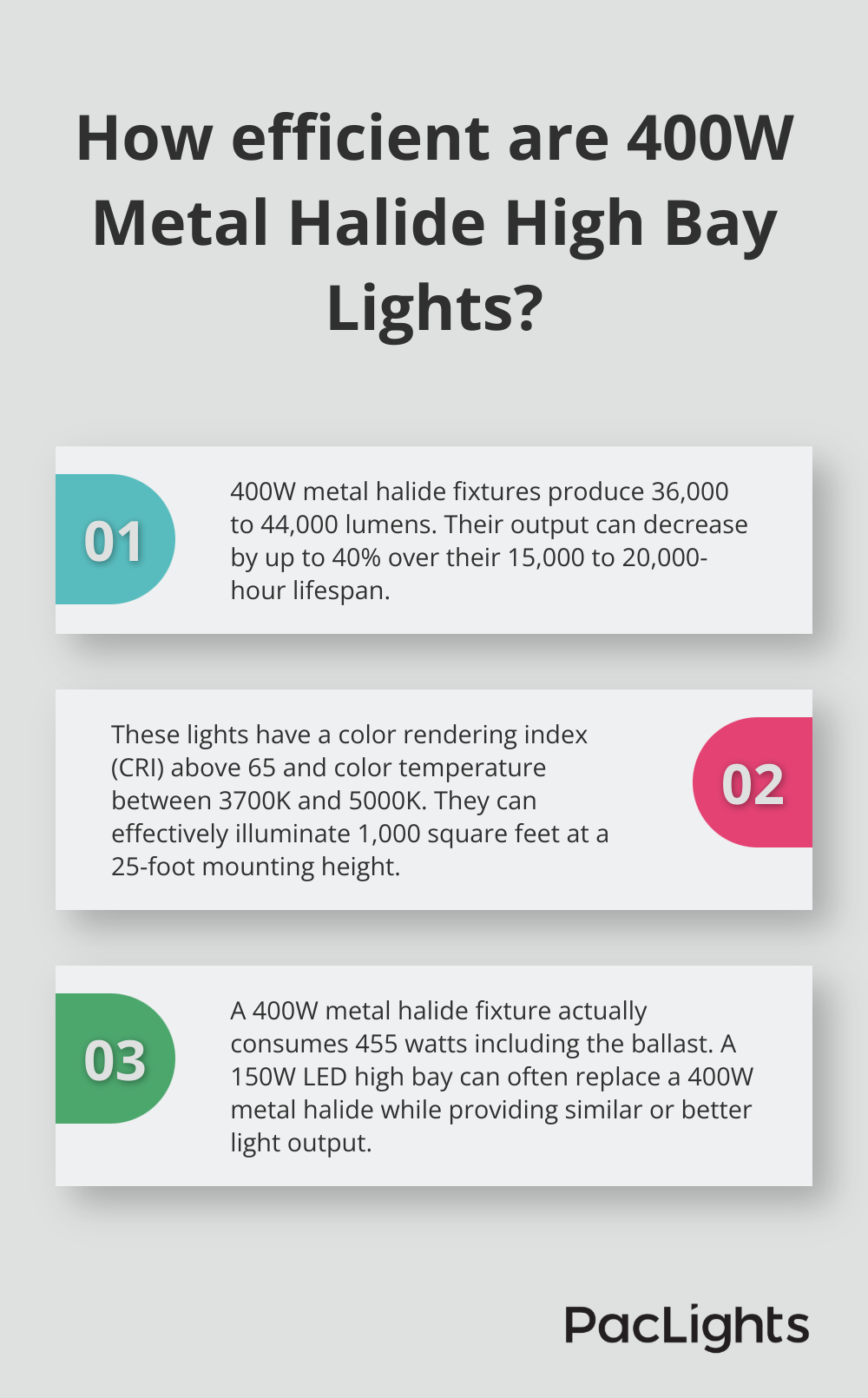
These fixtures boast a high color rendering index (CRI), often above 65, which allows for accurate color representation of objects in the illuminated space. The color temperature of metal halide lamps usually falls between 3700K and 5000K, providing a cool, crisp light that enhances visibility in work areas.
Common Applications for Metal Halide High Bays
Metal halide high bay lights serve as workhorses in various industrial and commercial settings. You’ll find them in warehouses, manufacturing facilities, and large retail spaces where ample, uniform lighting is essential for productivity and safety. Sports arenas and exhibition halls also benefit from the powerful output of these fixtures.
A typical warehouse might require about 30 to 50 foot-candles of illumination. A 400W metal halide high bay can effectively cover an area of approximately 1,000 square feet at a mounting height of 25 feet, making it a popular choice for these applications.
Energy Considerations
While metal halide lights have been industry standards for years, it’s important to note their energy consumption. A 400W metal halide fixture actually draws about 455 watts when you factor in the ballast. This higher energy usage translates to increased operating costs over time.
Alternatives to Consider
LED alternatives are increasingly becoming the preferred choice due to their energy efficiency and longer lifespan. For example, a 150W LED high bay can often replace a 400W metal halide fixture while providing similar or even better light output. LEDs also offer additional benefits such as instant-on capability and better dimming options.
As we move forward, it’s essential to weigh these factors when choosing high bay lighting. Let’s explore the specific considerations that will help you make an informed decision for your lighting needs.
Selecting the Right 400W Metal Halide High Bay
400W metal halide high bay lights serve as powerful illumination sources for large, high-ceiling spaces. This chapter explores the key factors to consider when choosing these fixtures, helping you balance performance, efficiency, and cost-effectiveness for your specific needs.
Light Output and Efficiency
The primary function of high bay lighting is to provide ample illumination for large spaces. A 400W metal halide lamp has an initial lumen output of 36,000. However, this output can decrease over its lifespan. This lumen depreciation plays a significant role in planning your lighting layout.
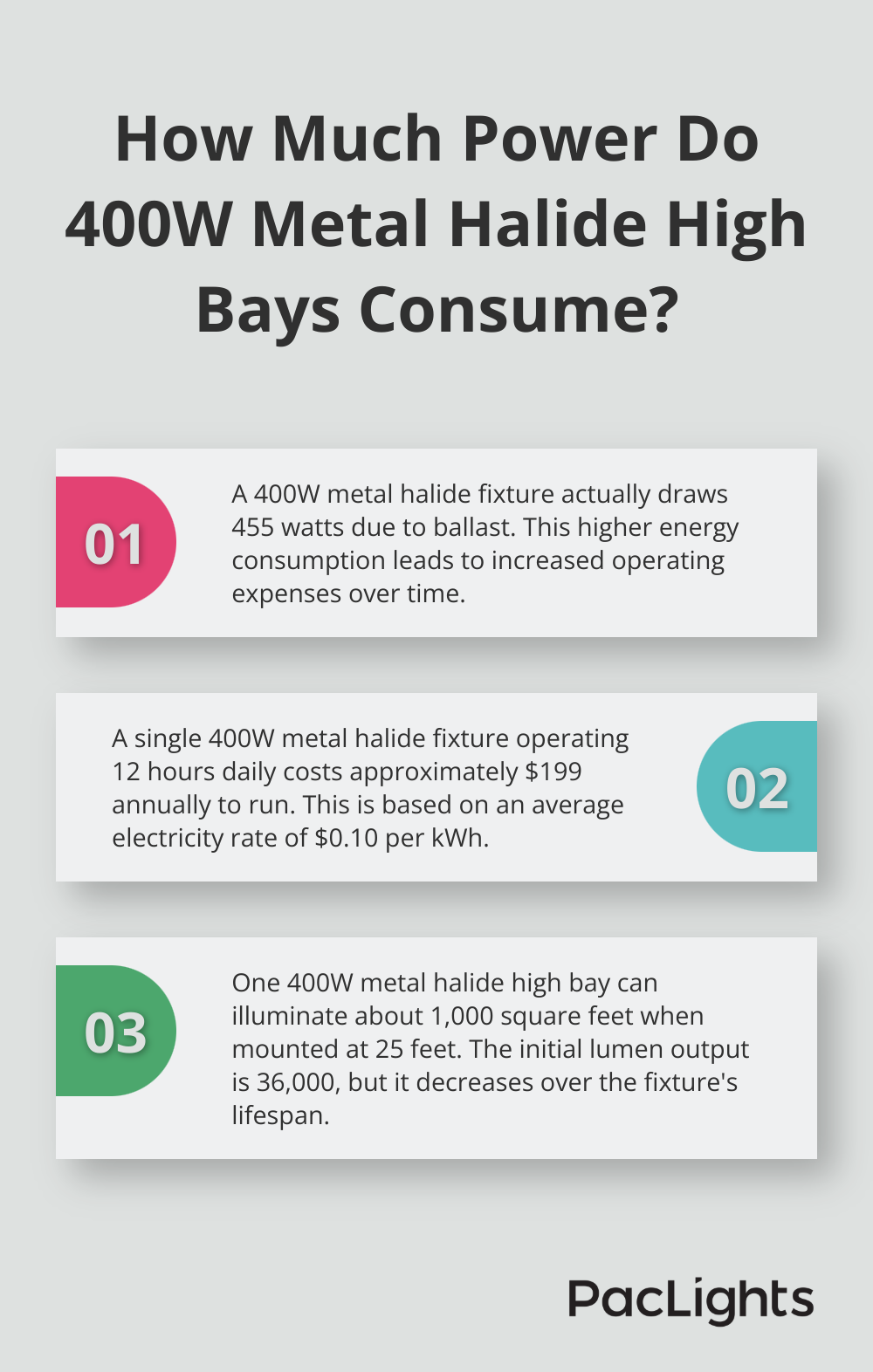
For optimal coverage, a single 400W metal halide high bay can effectively illuminate approximately 1,000 square feet when mounted at a height of 25 feet. This coverage area varies based on the specific requirements of your space and the desired foot-candle levels.
Color Quality and Temperature
Color rendering index (CRI) and color temperature significantly impact lighting quality. Metal halide lamps typically offer a CRI above 65, which provides good color accuracy for most industrial applications. However, tasks requiring precise color discrimination might benefit from options with higher CRI values.
The color temperature of metal halide lamps usually ranges from 3700K to 5000K, producing a cool, white light that enhances visibility in work areas. Industrial settings often prefer a color temperature of 4000K to 5000K, as it closely mimics natural daylight and helps maintain worker alertness.
Durability and Maintenance
Industrial environments can be harsh on lighting fixtures. When selecting 400W metal halide high bays, look for robust construction that withstands potential impacts, vibrations, and temperature fluctuations. Fixtures with an IP65 rating or higher offer protection against dust and moisture, which is essential for many industrial applications.
Maintenance is a significant consideration with metal halide fixtures. Factor in the accessibility of your fixtures and the frequency of required maintenance when making your decision.
Energy Consumption and Operating Costs
While 400W metal halide lights have been industry standards, they come with substantial energy costs. The actual power draw of a 400W metal halide fixture is closer to 455 watts when accounting for the ballast. This higher energy consumption translates to increased operating expenses over time.
To illustrate, a single 400W metal halide fixture operating 12 hours a day, 365 days a year, at an average electricity rate of $0.10 per kWh, would cost approximately $199 annually to run. Multiply this by the number of fixtures in your facility, and the energy costs can be significant.
It’s worth noting that LED alternatives can often replace a 400W metal halide fixture while maintaining or even improving light output. When evaluating your lighting options, consider not just the initial purchase price but also the long-term operating costs. A thorough cost analysis should include energy consumption, bulb replacement frequency, and maintenance requirements over the expected lifespan of the fixtures.
As we move forward, it’s important to compare 400W metal halide high bays with modern alternatives to make an informed decision for your lighting needs.
LED vs Metal Halide: A Lighting Showdown
Illumination and Efficiency Face-Off
A typical 400W metal halide fixture produces about 36,000 initial lumens. This output can decrease by up to 40% over its lifespan. In contrast, a 150W LED high bay delivers a consistent 21,000 lumens throughout its life. While the initial lumen output is lower, the sustained brightness of LEDs often results in better overall illumination over time.
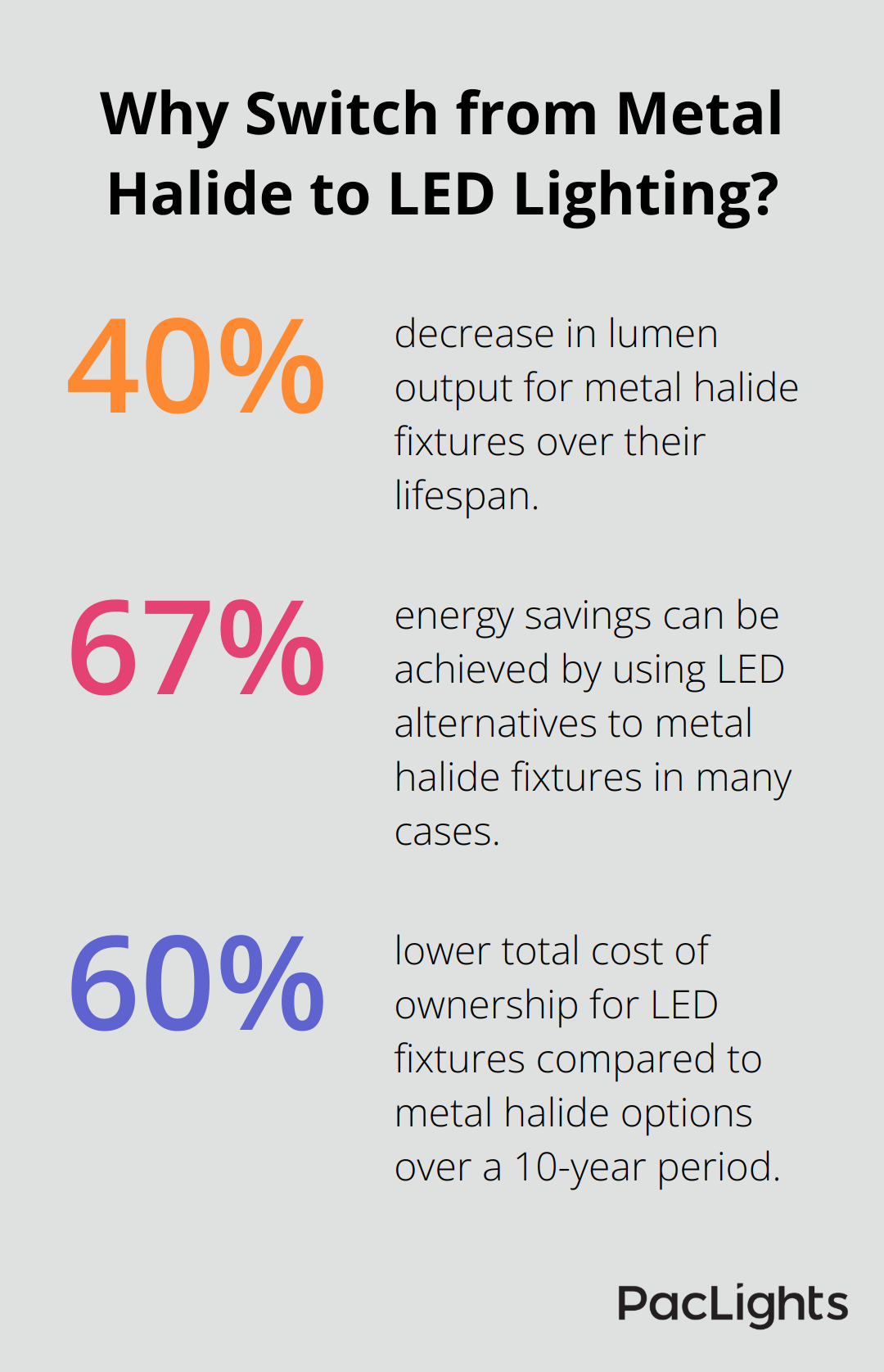
Energy efficiency is where LED technology excels. A 400W metal halide fixture consumes about 455W when accounting for the ballast. The 150W LED alternative uses only a third of this energy while providing comparable illumination. This translates to significant energy savings (up to 67% in many cases).
Longevity and Maintenance Benefits
The lifespan difference between these technologies is significant. Metal halide bulbs typically last 15,000 to 20,000 hours, requiring frequent replacements in high-use environments. LED fixtures can operate for 50,000 to 100,000 hours or more. This extended lifespan reduces maintenance needs and associated costs.
A warehouse operating 12 hours a day, 365 days a year, would need to replace metal halide bulbs every 3-4 years. LED fixtures could last 11-22 years under the same conditions. The reduction in maintenance frequency and costs can be substantial, especially in facilities with numerous fixtures or hard-to-reach areas.
Cost Considerations and ROI
LED fixtures generally have a higher upfront cost, but their long-term savings often justify the initial investment. Here’s a cost breakdown:
Initial cost: A 400W metal halide fixture might cost $150-$300, while a comparable LED high bay could range from $200-$500.
Energy costs: Using an average electricity rate of $0.10 per kWh and 12-hour daily operation, a 400W metal halide fixture costs about $199 annually to run. The 150W LED alternative would cost only $66 per year.
Maintenance: Factor in bulb replacements and labor costs for metal halide fixtures every 3-4 years.
Over a 10-year period, the total cost of ownership for LED fixtures is typically 50-60% lower than metal halide options. The exact savings depend on specific usage patterns and local energy rates.
Many facilities see a return on investment for LED upgrades within 2-3 years. For a more precise assessment, try to obtain free ROI calculations tailored to your specific situation.
Environmental Impact
The environmental impact of LED technology is noteworthy. LEDs contain no mercury, unlike metal halide bulbs, which makes disposal safer and easier. The reduced energy consumption of LEDs also translates to a lower carbon footprint for your facility.
400W metal halide high bay lights have long been a staple in industrial and commercial spaces. They offer powerful illumination and good color rendering for various high-ceiling applications. However, their declining light output, higher energy consumption, and frequent maintenance needs present significant drawbacks.
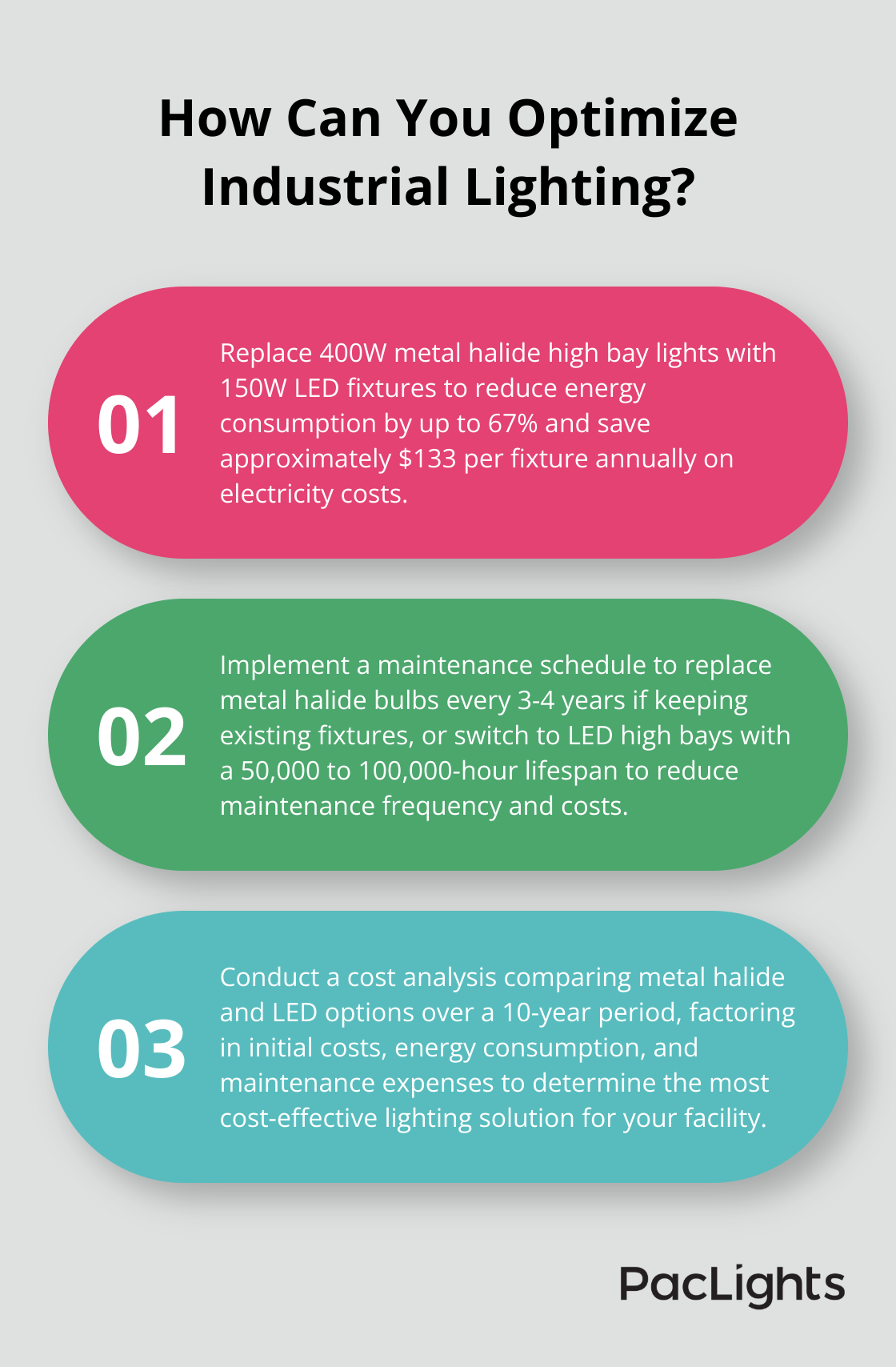
LED alternatives now provide comparable or superior illumination with substantially lower energy use. The long-term cost savings, reduced maintenance requirements, and environmental benefits of LED technology make it an attractive choice for many facilities. We at PacLights offer a wide range of energy-efficient LED fixtures designed to replace traditional metal halide high bay lights.
The choice between metal halide and LED lighting depends on your specific requirements, budget, and long-term goals. Our team can provide free lighting layout designs and ROI assessments to help you make an informed decision about upgrading your facility’s lighting. The lighting landscape continues to evolve, with advanced features like integrated sensors and networked controls becoming increasingly common.



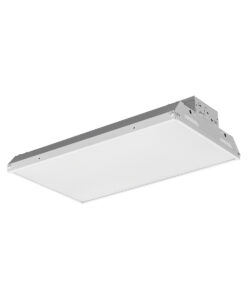
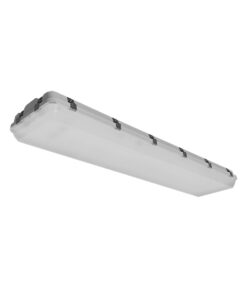

Disclaimer: PacLights is not responsible for any actions taken based on the suggestions and information provided in this article, and readers should consult local building and electrical codes for proper guidance.